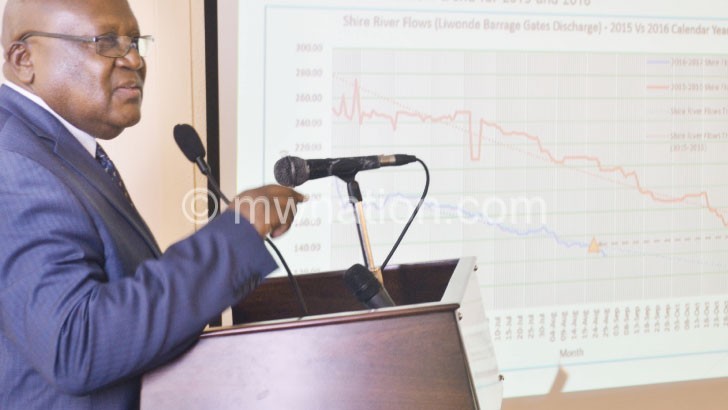Brace for extended blackouts—ESCOM
Malawians should brace for extended hours of load shedding as Electricity Supply Corporation of Malawi (Escom) says it has no immediate solutions to the current power outages.
Escom, which relies on water to produce its power, says the situation will be worse from September to December 2016 when rains are expected to start and improve water levels in Lake Malawi and its sole outlet, Shire River where over 90 percent of Escom’s power is generated.
Briefing journalists in Blantyre on Monday, Escom executive management led by chief executive officer (CEO) John Kandulu attributed the problem to challenges of water levels in the Shire River.
He said water flow in the Shire is set to worsen until the country receives enough rains. He added that Lake Malawi is at its lowest level in the past 15 years; hence, the situation.

a presentation on water levels during the press briefing
Said Kandulu: “There will be enormous operating difficulties in the months of September to December. Lake level will drop by early December and we will only be able to generate 135 megawatts (MW). Load shedding is likely to increase in the months to come.”
Escom’s production capacity is 361MW of electricity from all its sources combined, including the newly installed 10MW and 6MW diesel plants at Kanengo in Lilongwe and Mzuzu respectively.
Of late, Escom has been engaging independent power producers (IPPs) to generate power, including through the use of technologies such as solar, coal and wind, but the direction of those talks remain unclear as questions over pricing derail progress.
As a solution for now, the executives said Escom will procure 1.2 million light emitting diode (LED) bulbs in October to reduce load shedding.
In his remarks, Escom business development manager Wiseman Kabwazi said one LED bulb can produce light equivalent to 100 watts.
He said: “We are hoping to save 30 to 50MW of energy with the LED bulbs. This will reduce load shedding during the pe0ak hours from 6am to midday and 5pm to 9pm and minimal load shedding during the day.”
The LED bulbs will come on the market barely five years after Escom introduced energy saver bulbs which were then touted to have the potential to save up to 25MW of energy.
The Energy Efficient Lighting Project (EELP) was funded by Britain’s Department for International Development (DfID) and saw government distributing for free about two million bulbs.
Kabwazi said the bulbs are expensive, but efficient and they will be sold at subsidised prices to enable low income households to afford them. He added that the bulbs have a longer lifespan as they can last 15 to 20 years.
He said Escom is currently discussing with industries to shift their operating hours to off-peak hours as another measure to reduce power outages.
“We are offering special tariffs to industries who have agreed to operate during non-peak hours. We can ultimately save three to four megawatts. There is potential of saving up to nine megawatts if industries operate off-peak hours,” Kabwazi said.
On long-term plans, Kabwazi said Escom is looking at prospects of cross-border connection with neighbouring Tanzania, Zambia and Mozambique.
“We are looking at economic viability for the cross border projects power generation. A feasibility study and environmental impact assessment will be completed in 2017,” he said.
He also appealed to Malawians to switch off appliances that are not in use to conserve energy.
Power outages resulting from reduced generation capacity have in recent months negatively affected businesses and households alike, with some going at least 10 hours a day without electricity.
On Saturday, Malawi Confederation of Chambers of Commerce and Industry (MCCCI) told our sister newspaper, Weekend Nation, the prolonged power outages have crippled the private sector.
The chamber said some companies have been forced to produce at between 40 and 80 percent of their optimal capacity.





